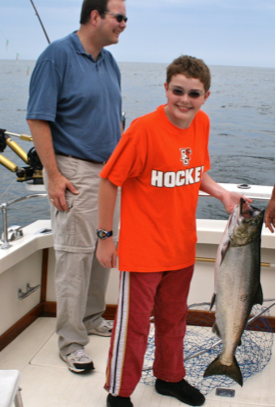
Young boy and father catching a Chinook salmon on Lake Michigan. Image: Eamon Devlin
By Eamon Devlin
When you reel up the salmon of your dreams, people may ask you how big or what kind it was.
It’s unlikely someone will ask where it was born.
But that’s what researchers at Michigan State University are now asking to understand how many Chinook salmon move from Lake Huron to Lake Michigan.
So, where are the fish born?
For researchers the answer lies in a bone in the fish’s head. Based on the concentrations of chemicals found in this bone, it can be used like a fingerprint linking the salmon to its stream of birth.
The bone is known as the sagittae.
“It picks up different chemicals, and a lot of heavy metals from the environment,” said Alex Maguffee, a Michigan State University master’s student in Fisheries and Wildlife, who is researching the question with Michael Jones, a fisheries biologist at the same university
The next question: Why are the salmon moving?
Chinook salmon eat alewives, an invasive fish to the area. Alewife populations in Lake Huron are declining. So, too, are the Chinook salmon populations, reports the Great Lakes Fishery Commission.
Salmon have begun to move from Lake Huron into Lake Michigan in search of alewives to eat, Maguffee said. “We know that they move, we just don’t know how much.”
Their study will help determine how many fish should be stocked. That’s important because too many fish mean that they won’t grow as big, and too few mean there aren’t as many to catch, Maguffee said.
He and other researchers are creating a mathematical model to predict the movements of fish from one lake to the other.
Biologists and other researchers can then estimate what proportion of fish will migrate based on the original number of fish stocked, said Maguffee. They can estimate how many salmon that are born in Lake Huron end up in Lake Michigan.
The information is needed by government agencies in Michigan, Minnesota and Wisconsin that stock salmon into the lakes.
The Michigan Department of Natural Resources is stocking fewer Chinook salmon in both Lake Huron and Lake Michigan based on the smaller salmon caught in recent years.
The Minnesota and Wisconsin departments of natural resources also report that they are cutting back on the salmon they supply Lake Michigan.
The question before such agencies: How many salmon should be stocked?
“The whole purpose of the experiment is to make sure we are stocking the correct number of salmon,” said Maguffee.
The idea is that with the help of the sagittae and the model, anglers can remain hooked on salmon for years to come.